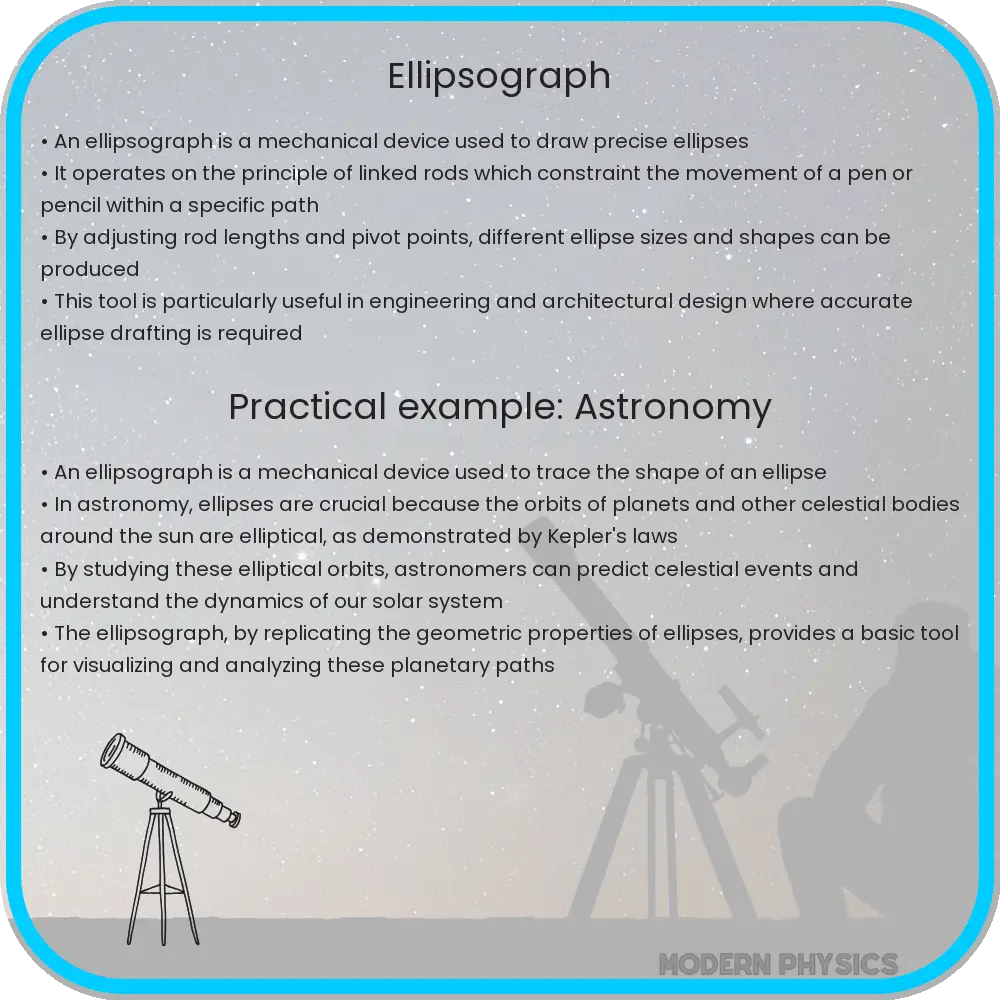Explore the ellipsograph’s blend of precision, design, and dynamics, from its historical roots to modern innovations in engineering and education.

Understanding the Ellipsograph: A Blend of Precision, Dynamics, and Design
The ellipsograph, an intriguing instrument in the world of geometry and engineering, has captivated minds with its blend of precision, dynamics, and elegant design. This device, dating back centuries, enables the drawing of perfect ellipses, a task that is deceptively complex when attempted by hand. The ellipsograph operates on fascinating mechanical principles, showcasing the beauty of mathematical accuracy in physical form.
Principles of the Ellipsograph
At its core, the ellipsograph functions based on a simple yet ingenious principle: the Trammel of Archimedes. This mechanism consists of two arms sliding at right angles to each other, with a pen or pencil attachment. The arms are set in such a way that their movement is constrained to a specific path, thus drawing an ellipse. This mechanism is a perfect embodiment of the equation of an ellipse, x2/a2 + y2/b2 = 1, where a and b are the semi-major and semi-minor axes, respectively.
Design and Materials
The design of an ellipsograph is not just about functionality but also about aesthetics and durability. Modern ellipsographs are often crafted from high-grade materials like stainless steel, brass, or even precisely machined aluminum, ensuring both accuracy and longevity. The choice of materials also affects the precision of the ellipses it can produce, making material selection a critical aspect of its design.
Applications in Various Fields
Ellipsographs find applications in numerous fields, ranging from engineering and architecture to graphic design and education. In engineering, they are used for creating accurate templates and prototypes. Architects utilize these tools for designing curved structures, while graphic designers find them invaluable for creating visually appealing layouts. Furthermore, in educational settings, ellipsographs serve as excellent tools for demonstrating the principles of geometry and mechanics.
The dynamic nature of the ellipsograph, coupled with its precision and design, makes it a timeless tool in both professional and educational arenas. Its ability to perfectly render ellipses, a fundamental geometric shape, is a testament to the intersection of art and science.
Technological Advancements in Ellipsograph Design
With the advent of digital technology, the traditional ellipsograph has evolved. Computer-aided design (CAD) systems can simulate the ellipsograph’s functionality, offering enhanced precision and the ability to design complex elliptical shapes easily. However, the physical ellipsograph remains popular for its tactile experience and direct control, especially in artistic and educational contexts.
Innovations and Future Directions
Recent innovations in ellipsograph design include adjustable arms for a wider range of ellipse sizes and shapes, as well as portable versions for fieldwork. The integration of digital components, such as laser guides and digital measurement tools, is also an emerging trend, enhancing precision and ease of use.
The Role of the Ellipsograph in Education
In educational settings, the ellipsograph is more than a drawing tool; it is a gateway to understanding complex mathematical concepts. By visualizing and manually creating ellipses, students gain a deeper understanding of geometry, physics, and mechanics. This hands-on approach makes abstract concepts tangible, fostering a more engaging and effective learning experience.
Conclusion
The ellipsograph, a marvel of engineering and design, elegantly bridges the gap between theoretical mathematics and practical application. Its enduring relevance in various fields, from engineering to education, highlights its versatility and the timeless nature of its design. As technology continues to advance, the ellipsograph will likely evolve, incorporating digital elements while retaining its fundamental principles. This blend of tradition and innovation ensures that the ellipsograph will remain an essential tool in precision drawing and a testament to the beauty of mathematical precision in the physical world.
In conclusion, the ellipsograph is not just a tool for drawing ellipses; it is a symbol of the harmony between art and science, a testament to human ingenuity, and a beacon for future innovations in design and technology. Its story is one of enduring precision, dynamics, and an ever-evolving design, inspiring generations of engineers, artists, and educators.
